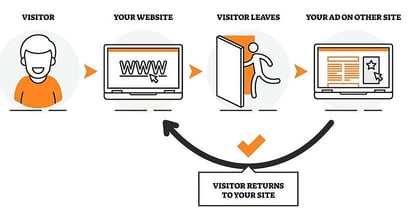As marketers, we hope and pray that every single person that sees one of our ads immediately understands the value of our products, comes to our website, converts into a sales-ready lead, and ultimately becomes a customer. But the reality is, a typical buyer’s journey is rarely a simple linear progression. It often involves a large amount of research done independently by the buyer before they ever reach out to a salesperson or fill out a form, during which time they might bounce around to many different websites including your competitors'. In fact, only around 2% of your website traffic will make the jump from anonymous traffic into a lead that has raised their hand via a contact form, direct email, chat, etc. So, how do you capture these high-value website visitors to get them back to your site and convert? One word: retargeting.
We often tote the power retargeting ads can have on your account-based marketing strategy, but it’s hard to understand the benefits without knowing exactly what they are and how they work.
Let’s start with some definitions:
Ad retargeting, also known as remarketing, is a highly effective process of showing ads to an audience that previously visited your website and left without converting.
Here’s what retargeting looks like:

- Visitor comes to your website
- They leave without converting :(
- As they browse the internet, they see your ad on a different website
- They click your ad
- They return to your site, perhaps to a custom-tailored landing page and ideally convert :)
Sounds great, right? But how do you do it?
In general, there are three major types of retargeting methods marketers can use:
Third-Party Retargeting: This approach relies on website cookies or tracking pixels that are designed to collect information about website visitors. When a user visits a website, the cookie is stored on the user’s browser and enables advertisers to “follow” them around the internet. After the visitor leaves the website, retargeting ads can be served to them through third-party networks, such as the Google Display Network and Facebook.
The benefit of third-party retargeting is that you can serve your ads to people who have visited certain pages on your site (ex: your pricing page) that show an elevated level of interest in your products.
However, the biggest drawback of this kind of retargeting is that as personal data protection has increased in recent years, legislation has severely crippled advertisers’ ability to use third-party tracking cookies (the ones used for retargeting). In addition, many browsers including Safari, Firefox, and Chrome have all adopted anti-cookie policies which have made this form of retargeting much less effective, if not impossible.
Contact List Retargeting: This method of retargeting works by leveraging a preexisting list of email contacts that have visited your website and have voluntarily offered up their email address often in exchange for something, such as gated content, webinar, product discount, etc. Once you have a list of visitor email addresses, you can upload it onto a retargeting ad platform, like Google Ads, Twitter, or Facebook, and the next time a user logs into a site using an email address on that list, they will be served your ad.
The main benefit of this type of retargeting is that it is much more focused than third-party retargeting and reduces the number of wasted ads served to people who visited your site by accident and immediately bounced. However, the downside of this kind of retargeting is that the audience you can retarget is much, much smaller than a third-party cookie/pixel-based audience because the visitors have to voluntarily give you their information in order to be added to a retargeting campaign. This will likely be a very small percentage of your website traffic (around 2%). In addition, if a visitor fills out a form on your website with one email address but uses a different one for their social media account, they won’t see your ad.
B2B Audience Retargeting: The third type of retargeting offers the best of both worlds – it provides a larger audience than list-based retargeting but also allows for highly personalized ads that are much more likely to resonate with your target audience and get them to click.
Audience-based retargeting works by first placing a small piece of code onto your website called a “tag.” Once configured, the tag identifies firmographic data about your website visitors such as: company name, industry, revenue, employee count, geolocation, and more, which are then used to build audiences within the Google Ads platform.
Once an audience is built, it can be added to a retargeting campaign (Google refers to this as remarketing) and you can serve ads to users at companies that fit your target profile (ex: manufacturing companies with 1000+ employees). In addition, you can exclude companies that may have visited your site but you do not want to market to (i.e. current customers, competitors, companies outside of your ideal customer profile, etc.). You can also dynamically adjust your bidding to ensure that you will always win an ad placement for your high-value visitors.
The only real drawback of this form of retargeting is that the firmographic data used to build retargeting audiences is strictly limited to businesses, so while it is highly effective for B2B marketers, it is not as useful for B2C marketers.
With the right retargeting strategy in place, you will no longer be limited to inbound leads coming from 2% of your website visitors. Instead, you’ll be able to take full advantage of your website traffic – recapturing visitors and converting them into valuable leads without blowing your ad budget. If you want to learn more about how to set up a successful retargeting campaign using Google Analytics & Ads, check out our guide!

